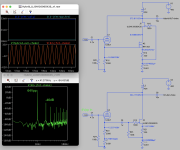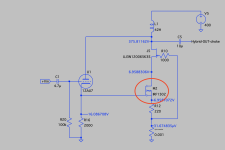In the 'search' for jFETs I found a hybrid SIC jFET: UJ3C120150 K3S
It is a 'normally-on jFET' combined with a driver mosfet:
Has anybody any experience with this in the PASS community?
Or is it secretly an iGBT?
It is a 'normally-on jFET' combined with a driver mosfet:
1200V. 10A. >120W. zero input capacitance (sorry I dream: Ciss is actually rather high, then can't they handle that embedded driver better??). But at least: the curve is that of a jFET.This SiC FET device is based on a unique ‘cascode’ circuit configuration, in which a normally-on SiC JFET is co-packaged with a Si MOSFET to produce a normally-off SiC FET device. The device’s standard gate-drive characteristics allows for a true “drop-in replacement” to Si FETs, SiC MOSFETs.
Has anybody any experience with this in the PASS community?
Or is it secretly an iGBT?
Attachments
Last edited:
It is used where the SIT (2SK182e) was used before:
- EV charging
- PV inverters
- Switch mode power supplies
- Power factor correction modules
- Motor drives
- Induction heating
- audio?
Last edited:
audio . . . because this "SiCFET (Cascode SiCJFET)" device, in the lower left of the curves, matches/is sort of similar to a SJEP120R100 . . . and is just made more universal (that is, commercially), not needing a negative bias.

and if you don't mind, a C3M0120065D looks promising in comparison of those curves too. A UF4C120070K3S is more hefty and cheaper.
But MSC090SMA070B looks like a killer.


and if you don't mind, a C3M0120065D looks promising in comparison of those curves too. A UF4C120070K3S is more hefty and cheaper.
But MSC090SMA070B looks like a killer.

Attachments
Last edited:
Hello triodw_al,
a few other members had these SiCFETs on the focus...
https://www.diyaudio.com/community/threads/sic-adventures-exploring-the-uj3n065080k3s.409636/
and some others...
interesting!
Cheers
Dirk
a few other members had these SiCFETs on the focus...
https://www.diyaudio.com/community/threads/sic-adventures-exploring-the-uj3n065080k3s.409636/
and some others...
interesting!
Cheers
Dirk
Yep. Looked at Pinholers progress, very interesting.
To me, the UJ3C120150 is also a 'nice behaved device' to do some paralell-drive (such as a tube of which the cathode current drives the jFET).
Maybe. . . Should I order both? My box of unused parts is rather full 🤢 . . .
To me, the UJ3C120150 is also a 'nice behaved device' to do some paralell-drive (such as a tube of which the cathode current drives the jFET).
Maybe. . . Should I order both? My box of unused parts is rather full 🤢 . . .
Last edited:
my sole criteria is that Ugs can't be higher than 5V for 2A
if it is, much more complicated circuitry for small amps, negating any possible difference to regular mosfets performance in similar amps
still useful for bigger amps, but I'm not so interested in greater power range, in any context
if it is, much more complicated circuitry for small amps, negating any possible difference to regular mosfets performance in similar amps
still useful for bigger amps, but I'm not so interested in greater power range, in any context
I have been working last year on designing a tube-based SE amplifier, where the cathode current of a 300B or even 6SN7 will drive a mosfet, such that the combo is a servo. Could also work into choke to get e.g. . 30V or 40Vpp with ease and hence to a follower circuit.. Or a transformer with some appropriate secondaries.
A normally-off SIC-jFET would be ideal as it would just fit in with a cathode resistor of 1000Ω. And drive the mosfet nice. (I saw that the SJEP models are great for such servos).
A normally-off SIC-jFET would be ideal as it would just fit in with a cathode resistor of 1000Ω. And drive the mosfet nice. (I saw that the SJEP models are great for such servos).
audio . . . because this "SiCFET (Cascode SiCJFET)" device, in the lower left of the curves, matches/is sort of similar to a SJEP120R100 . . .
For analogue audio, I am more interested in Id Vs Vgs.
Id Vs Vds doesn't tell me a lot.
Patrick
Au contraire, my SemiSouth SIT-1 devices are very triodey.
Alas, they were custom fabs and SemiSouth is no more.
I do have a small stash in my safe deposit box at Fort Knocks...
Alas, they were custom fabs and SemiSouth is no more.
I do have a small stash in my safe deposit box at Fort Knocks...
Those are Nelson Pass specials.
Not the "normal" Semisouth's that normal people are talking about.
😊
Patrick
Not the "normal" Semisouth's that normal people are talking about.
😊
Patrick
This is sort of the concept: a cathode follower driving a jFET while the anode is also connected to the load - such that there is some 'triody feedback' going on.I have been working last year on designing a tube-based SE amplifier, where the cathode current of a 300B or even 6SN7 will drive a mosfet, such that the combo is a servo. Could also work into choke to get e.g. . 30V or 40Vpp with ease and hence to a follower circuit.. Or a transformer with some appropriate secondaries.
A normally-off SIC-jFET would be ideal as it would just fit in with a cathode resistor of 1000Ω. And drive the mosfet nice. (I saw that the SJEP models are great for such servos).
Note there are two curves visible in the bottom panel.

The other one is a hybrid mosfet/SIC-jFET - I have seen an article explaining schema's with such a configuration as the concept of the single-house combo to get a high threshold Vin. There is almost no difference in the amplification nor in the distortion . . .

- maybe the 220Ω source resistance does all the work of creating the harmonics and amplification, without decoupling.
Anyway, statically the idea 'works'. It has rather high residual distortion right now - the feedback?
A follow up can be a combo with a pure driver tube - such as a triode-connected power pentode - like the one on my avatar, used as preamp - or even a 300B.
Looking at the SIC-jFET curves, a hybrid with a mosfet on top forcing the jFET in the non-lineair/resistive region is more interesting for triode curve lovers.
Last edited:
Looking at the SIC-jFET curves, a hybrid with a mosfet on top forcing the jFET in the non-lineair/resistive region is more interesting for triode curve lovers.
You just need to use the LU1014 in a triode cell.
Costs much less.
www.diyaudio.com/community/threads/the-lu1014-circlotron-power-buffer.399639/
Patrick
Will do then, LU1014 is better, I even have 'm, just I need to get a copper-substrate pcb. 'Just'; well I'll make a board layout in 10x10 formats including the cascode I think and JLCpcb them . 
Its going to be just experimental - no matching to 3 coefficients in a 6th order polynomial of Id vs Vgs.
A mock-up of a Zen v9 triode. Nice. There I saw a nice little layout too.

Its going to be just experimental - no matching to 3 coefficients in a 6th order polynomial of Id vs Vgs.
A mock-up of a Zen v9 triode. Nice. There I saw a nice little layout too.
The Lovoltech is cheaper, but not necessarily better. I've tried both and I like the UnitedSiC UJ3N065080K3S in common source single-ended configuration the best so far. Anyways, for DIY, a few dollars is not much for the fun of experimenting and learning. Better to do it than read about it.
Aluminum PCB substrates work well for the LU1014. Probably cheaper than copper.
Aluminum PCB substrates work well for the LU1014. Probably cheaper than copper.
- Home
- Amplifiers
- Pass Labs
- a hybrid SIC jFET: UJ3C120150 - any experiences?